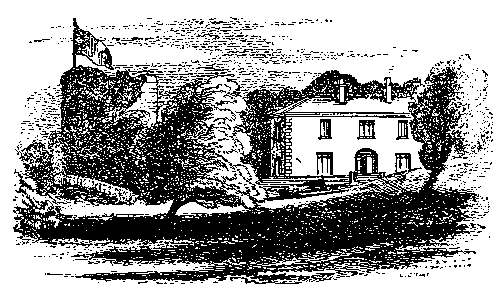Chapter 6: Inis Uí Chuinn to Inis A' Ghaill and Cunga Fheichín (Cong)
- Islands of Loch Coirib
- Shrule
- Ballycurrin House
- Inchagoill
- Inís mhic a'trír
- Cross Castle
- Ancient Churches of Cill Fraocháin
- Moytura
- [?? no title yet]
Return to table of contents
Refer to Map
Besides the great tower at Shrule, there are several ruined castles in the western extremity of this parish, of which the most extensive and best preserved is Baile Cuirrín [Ballycurrin House ].

This old tower-house, or defensive mansion, consists of a quadrangular ivy-mantled keep--now somewhat altered for modern purposes--sixty-four feet long on the south, thirty-nine on the west face, and forty-seven feet high; but possessing no architectural memorial by which to assign even a probable date to it; as the dressed stones are not chiselled, but punched, or what is styled "sparrowpicked"; massive defence and security having evidently been the main objects of its founders. Both it and the newer residence are most pleasingly situated on a green slope, rising from a sheltered little bay, and surrounded by a large park of well-grown timber. There is no reference to this ancient building in our histories or inquisitions; and the only legend attaching there to is, that it was built in the "ould times" by one of three brothers, the two others of whom erected those of Ballynahinsey and Moceara (possibly Mac Ceara), with which it forms a triangle. After the Milesian invasion, our bardic histories say that one of that race, named "Caicer, erected a castle at Dún Inn, in the West of Ireland." Upon the shore adjoining Ballycurrin there exists a mound, or earthen tumulus of that name, and mentioned in Keating's History of Ireland. There is, however, no mortared structure in Ireland older than the Christian Era. And he is also of opinion that Ceara, one of the artificers said to have come over at that time left his name to many localities in Connacht--such as Loch Ceara, Caiseal Ceara; and in this immediate neighbourhood, Tobar Ceara and Gáirrín Ceara, or Ceara's well and garden. In the old quit rent receipts Ballycurrin is called Ballycar, possibly a corruption or anglicized version of Baile Ceara. In the vicinity was found the collection of amber beads, and several bronze antiquities, now in the collection of the Royal Irish Academy.